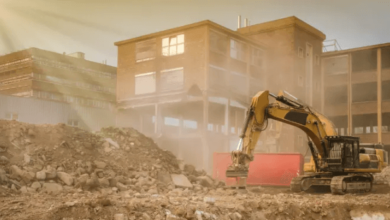Site Safety – The Importance of Creating a Safe Worksite

Construction sites must adhere to rigorous safety standards in order to avoid accidents, injuries and costly fines. From how dangerous chemicals are handled to how the scaffolding stands at height – every aspect must meet safety regulations.
Prioritizing site safety can not only protect workers but also increase morale and productivity on construction sites. Here are a few ways you can make your construction site safer:
Know What You’re Working With
Though many skills for construction workers can be learned on-the-job, safety education should always come first. Through training sessions or briefing documents, every person who enters a construction site should receive proper instruction regarding standards to follow and how these should be applied – including subcontractors.
Site safety like this must also include information on how to recognize hazards and take the appropriate actions when they arise, which can be done through using signs, barriers and clear markings or performing regular inspections on equipment and scaffolding to detect any potential issues as soon as they’re identified and make necessary corrections as soon as they’ve been discovered.
Setting up a site plan is essential for construction projects, going far beyond OSHA requirements. Such plans should cover demolition, new construction, excavations, underpinning jobs with higher public risk exposure as well as jobs that pose greater dangers than normal to public health and safety. In some instances, some sites may even need an on-site safety manager.
An effective site plan should include information on construction fence locations, full list of hazardous materials present on-site and their locations, accident/incident reporting system and emergency first aid stations as well as an effective hazard identification program and standard operating procedures that should be provided during worker inductions.
Get the Right Equipment
Equipment used by workers plays a critical role in their safety. This is especially true of construction workers, as they rely heavily on tools and machinery they rely upon to get their jobs done. Ensuring they have high-quality tools as well as providing daily inspection procedures can help avoid accidents caused by malfunctions with such machinery.
Workers need not only have access to appropriate equipment but must also know how to operate it safely themselves. Therefore, providing proper training and organizing regular meetings are crucial in making sure all employees understand proper procedure and can identify potential dangers before they result in accidents.
An effective way to prevent injuries is keeping a first-aid kit handy. Even minor accidents can become life-threatening without prompt treatment; be sure to include all OSHA-required items, as well as contact numbers of primary medical care providers in the kit.
Plans are an integral component of all construction projects, helping minimize risks, accidents and incidents by outlining clear procedures for everyone to abide by. Many states mandate site plans for large building projects with excavations or modifications that affect public risk or other jobs involving increased exposure to hazards.

Train Your Employees
One key element of site safety is ensuring all employees receive adequate training. While some training may be mandated by law or accreditation agencies, other measures fall under the responsibility of contractors who must implement site specific training as well as employee development programs for optimal site performance.
Establish a comprehensive program, from identifying potential hazards to understanding equipment and procedures. You can learn more from this site – https://amerisafegroup.com/category/blog/safety-culture/ as well as the links, within. Frequent training sessions should be held so as to keep this knowledge fresh in all employees’ minds, including managers, supervisors, full and part time temporary workers as well as managers themselves.
Training should focus not only on what to do, but also why. This will enable participants to understand the significance of an action or avoidance technique and give them tools for being proactive when faced with potential issues.
Training should always be engaging and interactive to maximize learning and retention. One effective strategy to accomplish this goal is by tailoring training content directly to job responsibilities while using real-life examples whenever possible; you may also employ repetition or group learning techniques to bolster participants’ comprehension of material presented.
Read also: Polymer Concrete: Know All The Things About It
Make Safety a Priority
Establishing a company culture where safety is at the forefront will help your employees go home healthy each day from work. This will make your company an appealing workplace as staffing challenges continue and competition for qualified workers increases. Increasing employee safety efforts will boost morale making your workforce happier and more productive on the job.
All new hires and temporary workers should undergo an intensive program orientation session before beginning to work for their employer, covering everything from hazard recognition to the company policies and procedures for worker conduct. Managers and supervisors should participate in ongoing safety training so they remain up-to-date on all of the latest techniques for improving policies.
Site plans are necessary for many construction projects, such as demolition, excavations, underpinning jobs that increase public risk and modifications of more than half of a floor area. By having one in place you can effectively mitigate and prevent hazards, injuries and other risks on your construction project – helping it be completed without issues or setbacks.




